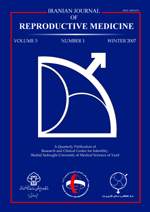
|
International Journal of Reproductive BioMedicine
Research and Clinical Center for Infertility, Shahid Sadoughi University of Medical Sciences of Yazd
ISSN: 1680-6433
EISSN: 1680-6433
Vol. 14, No. 10, 2016, pp. 629-636
|
 Bioline Code: rm16081
Bioline Code: rm16081
Full paper language: English
Document type: Research Article
Document available free of charge
|
|
|
International Journal of Reproductive BioMedicine, Vol. 14, No. 10, 2016, pp. 629-636
| en |
Ovarian and uterine alterations following forced swimming: An immunohistochemical study
Saadat, Seyedeh Nazanim Seyed; Mohammadghasemi, Fahimeh; Ebrahimi, Hannan; Sajedi, Hanieh Rafati & Chatrnour, Gelayol
Abstract
Background: Physical exercise is known to be a stressor stimulus that leads to reproductive disruption.
Objective: The aim of this study was to evaluate the effect of forced swimming on the uterus and ovaries in mice.
Materials and Methods: Adult mice (N=24) were divided into the following three
groups: A, control; B, swimming in water (10oC); and C, swimming in water (23oC).
Swimmers swam for 5 min daily for 5 consecutive days/ wk during 2 wks. An
enzyme linked immunosorbent assay was used to determine serum estradiol, follicle
stimulating hormone (FSH) and testosterone levels. Immunohistochemistry was
performed to study apoptotic cells or estrogen receptor (ER) expression in uterine
epithelial cells and ovaries. ANOVA was used for statistical analysis56T.
Results: Swimming in both groups reduced the serum FSH and estradiol levels (p<0.01) without having a significant effect on the serum testosterone level or percentage of apoptosis in ovarian and uterine tissues (p<0.01) compared with controls. A significant reduction in the number of ERs in the uterus and ovaries, and secondary and graafian follicles were observed in groups B and C compared with controls (p<0.01); however the number of primordial and primary follicles were not significantly changed in the ovaries.
Conclusion: Forced swimming of 2 wks duration reduces the serum levels of FSH and estradiol without having effects on apoptosis in the ovaries or uteri of mice. Over a long period of time, forced swimming may have an adverse effect on fertility.
Keywords
Swimming; Uterus; Ovary; Estradiol; Apoptosis; Estrogen receptor
|
| |
© Copyright 2016 - Iranian Journal of Reproductive Medicine
Alternative site location: http://www.ijrm.ir
|
|
